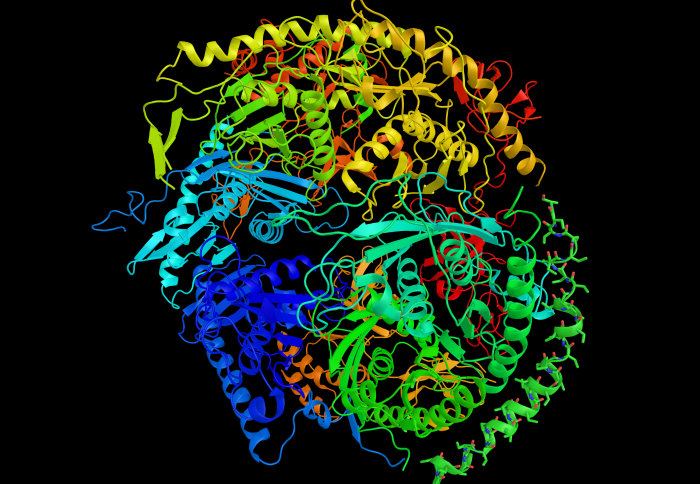
A complex protein folded into its functional shape

Proteins behaving badly and the havoc they cause in the human body were the key themes of the 2018 Sir Ernst Chain lecture.
The annual lecture has become one of the most prestigious events in Imperial's calendar.
This year, renowned chemist Professor Christopher Dobson from the University of Cambridge, was the invited speaker, delivering a lecture focused on diseases that stem from rogue proteins.
He explained how the presence of amyloid, a rogue state of proteins which enables them to clump together, is now known to link a whole range of conditions with different symptoms and outcomes.

As the fundamental machines and building blocks of biology, proteins are involved in virtually every chemical process in living systems. But when they go wrong, the effects can be devastating, leading to a range of diseases from diabetes and types of cancer, to Alzheimer's and Parkinson's disease.
Professor Dobson explained how just 20 types of amino acid are linked together in limitless combinations to make up polypeptide chains. However, these chains are just the beginning of the story, and through numerous twists and kinks, they are folded into the protein's final functional shape. It's this process, he explained, which holds great potential for things to go awry and for disease to occur.
FOLDING FAILURE
During the folding process, proteins twist and bend to create structures, including ordered sheets and twisting helices, with many larger proteins mixing and matching these shapes, resulting in incredibly complex structures.
"Even a few mistakes in one molecule is enough to generate catastrophe for the cell," said Professor Dobson. "Folding is a very complex process and takes place in a very complex environment. And anything that's complex is going to go wrong sometimes."
As they form, molecular chaperones in the cell 'look after' the developing proteins, stopping them from 'sticking' to other molecules before they are folded into the correct shape. But misfolding can lead to 'sticky states', where proteins aggregate into 'amyloid deposits' -- so called because of the dye used to detect them.
"Even a few mistakes in one molecule is enough to generate catastrophe for the cell" Professor Christopher Dobson Speaker, Sir Ernst Chain Lecture 2018
These amyloid deposits are now known to be linked with a number of diseases, among them Alzheimer's, which is characterized by deposits of two abnormal proteins in the brain; AB plaques, and tau tangles, linked with the demise of neurons.
However, Professor Dobson explained that Alzheimer's is far from unique, but is one of a group of some 50 recognised conditions associated with the deposition of proteins, including type 2 diabetes and spongiform encephalitis, all of which are "essentially untreatable".
He explained that as much as 10% of the world's population may suffer from diseases where misfolded proteins play a role.
GROWING FIBRILS
Investigation has revealed that despite their differences, these conditions all have one feature in common, strands of hardened, thread-like protein deposited within cells.
"We were immediately intrigued by what these structures are," said Professor Dobson. "They're pretty much the same in every disease, even though the proteins themselves are very different."

He explained how these fibrils form from protein fragments which then 'grow' within the cell, as other amyloid fragments stick to their ends and increase the fibril's length.
But these fibrils can also break, giving rise to two smaller strands which can themselves go on to grow -- if left unchecked, the process can lead to an exponential growth in fibrils.
Touching on the lack of treatments for Alzheimer's and other conditions where protein misfolding plays a role, Professor Dobson offered: "One should be very optimistic for the future...we have only had 30 years to realize their importance, and most people didn't know the basis of these diseases. But this has really changed."
HOPES FOR TREATMENT
Research has revealed how cells use biological mechanisms to spot and tackle rogue proteins -- including molecules which recognise misfolded regions of a protein and single it out for destruction. But these generally decline with age. Learning from the same biological quality control mechanisms, researchers are now developing tools to mimic their action.
Just as chaperone molecules in cells are able to bind to the amyloid polymers at key sites to stop them from growing further, Professor Dobson explained how a number of antibodies are being developed to mimic them, targeting fibrils and stop them from forming.
Early trials in nematode worms are showing positive results, with treatments reducing the damage of amyloid and maintaining cellular function.
Ending on the hope to take these new treatments into clinical trials, Professor Dobson said: "I'm very confident that, although so far there has been a lack of success in drug discovery, these designs show we can actually deal with the disease...and [early results are] looking extremely promising."
Article text (excluding photos or graphics) available under an Attribution-NonCommercial-ShareAlike Creative Commons license.
Photos and graphics subject to third party copyright used with permission or © Imperial College London.
Reporter
Ryan O'Hare
Communications Division

Contact details
Tel: +44 (0)20 7594 2410
Email: r.ohare@imperial.ac.uk
Show all stories by this author




Leave a comment
Your comment may be published, displaying your name as you provide it, unless you request otherwise. Your contact details will never be published.